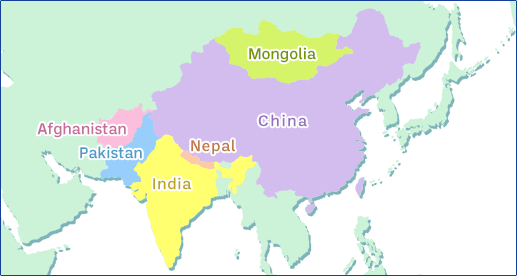
Yogurt in Asia
Afghanistan / India / China / Nepal / Pakistan / Mongolia

Afghanistan
In central Afghanistan, yogurt variants are made from sheep milk, and in the mountainous regions in the northern and southern regions camel milk is mostly used to make fermented milk products, while cow milk is used in the rest of the country. Doogh (also called “シュルンベ”), one of the most popular fermented milk products in the country, is prepared as follows. First, milk is boiled and cooled, and then mixed with a curd (starter culture) called “マスティ” to ferment, which produces mast. Next, it is put into copperware or a leather sack, and churned to remove the butter. The resulting buttermilk is the doogh, which can be consumed as a beverage or processed for other cooking purposes. Chhaka is curdled doogh, which is made by placing doogh into a cloth sack and draining away the whey. Kurt is a preserved yogurt variant commonly eaten in Afghanistan, which is prepared by taking the coagulated substance that forms on the top of doogh when it is heated up, putting it into a cloth sack to drain, salting and forming it into small balls, and drying them in the sun, which are then dissolved with water for cooking.
India
It is said that India was the first country in Asia that started including milk in the diet. Dahi is a yogurt-like fermented milk that has been made and consumed in India since ancient times. Various methods of preparing homemade dahi have been passed down through the generations, and it has become an essential part of cooking in Indian households. The basic process is to first sterilize cow milk or buffalo milk by heating, and mix it with a starter culture (i.e., leftover dahi), and ferment it at room temperature for a half day. Dahi is used to prepare meat dishes, salads, and beverages. Dahi can be found on the dining table of virtually every household, and is consumed according to individual preference. Lassi is an Indian version of buttermilk, which is made by stirring dahi and removing the butter that rises to the surface. Shrikhand is another cultured dairy product unique to India, which is prepared by removing whey from dahi (which is called “chakka”), adding sugar, and mixing until it becomes creamy. Shrikhand is eaten as a dessert but can also be used as an ingredient to make confectionery.
China(Inner Mongolia and Tibet)
In Inner Mongolia and Tibet in the Himalaya where the Mongols have settled, grazing is practiced and milk is used in a manner similar to Mongolia and Nepal. There is a traditional fermented skim milk called “edosensuu,” which is prepared by stand-fermenting milk, and removing the cream that rises to the surface. Its variation, called “スーンホロート,” is made by heating edosensuu, removing the whey, and drying the resulting curd; this is a preserved food usually consumed in winter, and is dissolved with milk tea before being eaten. Tarag is another cultured dairy product unique to the regions, which is prepared by heating milk, removing the cream to make condensed milk (called “ボルソンスー”), inoculating it with a starter culture, and then stand-fermenting it; it can be eaten as is. Airag made from horse milk is called “tsege” or “chigee,” which is also commonly consumed by women and children. Tibet has its own yogurt variants, such as ツォー, which is a fermented yak milk, and ダ・ラ, which is a type of buttermilk unique to the country. Tibet also has dahi similar to Nepal, from which variants of yogurt such as chura and chhurpi are made.
Nepal
Because Nepal is situated in the mountains at high altitudes, it is inhabited by Himalayan cattle, yaks, buffaloes, and goats that have adapted to the environment. All dairy products found in Nepal are made from dahi similar to that found in India. To make any fermented milk product, dahi is first churned to produce butter and buttermilk. From this butter, the butter oil “ghee” is produced. When the buttermilk is heated up to create curd and the whey is removed from it, the remaining part is called “chura.” When this chura is formed into cakes or tubes and air-dried, it becomes a preserved food called “chhurpi.”
Pakistan
In Pakistan, buffaloes are raised along the Indus River, while goats and cattle are raised in the mountains. The milk of those livestock animals is fermented to make dahi, which is consumed as a beverage, and is also used to make カルート, a preserved food that is prepared by removing the whey from dahi, and forming the remaining curd into small balls, and drying them.
Mongolia
Mongolia is one of the leading countries in Asia in livestock farming, involving cattle, goats, sheep, horses, and camels, and the milk of all of these animals is consumed as a staple food. Tarag is the Mongolian-style skim milk that is prepared by letting milk sit to ferment naturally, and removing the cream that rises to the surface (called “zookhii”). Tarag can be eaten as is, or used as an ingredient to make dried dairy products. Airag is a fermented horse-milk liquor with an alcohol content of over 2.5% which is equivalent to that of kumis produced in Kazakhstan and Russia. Airag is popular and is considered a national drink in Mongolia. This horse-milk-based spirit can only be produced during the summer season (i.e., two-month period from July to September) when horses are milked. Due to the high alcohol content of airag, it can be distilled to make arkhi, a Mongolian vodka.



















